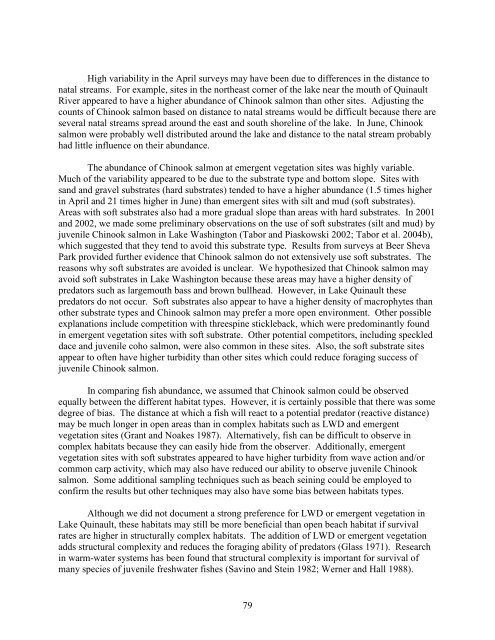Nearshore Habitat Use by Juvenile Chinook Salmon in Lentic ...
Nearshore Habitat Use by Juvenile Chinook Salmon in Lentic ...
Nearshore Habitat Use by Juvenile Chinook Salmon in Lentic ...
You also want an ePaper? Increase the reach of your titles
YUMPU automatically turns print PDFs into web optimized ePapers that Google loves.
High variability <strong>in</strong> the April surveys may have been due to differences <strong>in</strong> the distance to<br />
natal streams. For example, sites <strong>in</strong> the northeast corner of the lake near the mouth of Qu<strong>in</strong>ault<br />
River appeared to have a higher abundance of <strong>Ch<strong>in</strong>ook</strong> salmon than other sites. Adjust<strong>in</strong>g the<br />
counts of <strong>Ch<strong>in</strong>ook</strong> salmon based on distance to natal streams would be difficult because there are<br />
several natal streams spread around the east and south shorel<strong>in</strong>e of the lake. In June, <strong>Ch<strong>in</strong>ook</strong><br />
salmon were probably well distributed around the lake and distance to the natal stream probably<br />
had little <strong>in</strong>fluence on their abundance.<br />
The abundance of <strong>Ch<strong>in</strong>ook</strong> salmon at emergent vegetation sites was highly variable.<br />
Much of the variability appeared to be due to the substrate type and bottom slope. Sites with<br />
sand and gravel substrates (hard substrates) tended to have a higher abundance (1.5 times higher<br />
<strong>in</strong> April and 21 times higher <strong>in</strong> June) than emergent sites with silt and mud (soft substrates).<br />
Areas with soft substrates also had a more gradual slope than areas with hard substrates. In 2001<br />
and 2002, we made some prelim<strong>in</strong>ary observations on the use of soft substrates (silt and mud) <strong>by</strong><br />
juvenile <strong>Ch<strong>in</strong>ook</strong> salmon <strong>in</strong> Lake Wash<strong>in</strong>gton (Tabor and Piaskowski 2002; Tabor et al. 2004b),<br />
which suggested that they tend to avoid this substrate type. Results from surveys at Beer Sheva<br />
Park provided further evidence that <strong>Ch<strong>in</strong>ook</strong> salmon do not extensively use soft substrates. The<br />
reasons why soft substrates are avoided is unclear. We hypothesized that <strong>Ch<strong>in</strong>ook</strong> salmon may<br />
avoid soft substrates <strong>in</strong> Lake Wash<strong>in</strong>gton because these areas may have a higher density of<br />
predators such as largemouth bass and brown bullhead. However, <strong>in</strong> Lake Qu<strong>in</strong>ault these<br />
predators do not occur. Soft substrates also appear to have a higher density of macrophytes than<br />
other substrate types and <strong>Ch<strong>in</strong>ook</strong> salmon may prefer a more open environment. Other possible<br />
explanations <strong>in</strong>clude competition with threesp<strong>in</strong>e stickleback, which were predom<strong>in</strong>antly found<br />
<strong>in</strong> emergent vegetation sites with soft substrate. Other potential competitors, <strong>in</strong>clud<strong>in</strong>g speckled<br />
dace and juvenile coho salmon, were also common <strong>in</strong> these sites. Also, the soft substrate sites<br />
appear to often have higher turbidity than other sites which could reduce forag<strong>in</strong>g success of<br />
juvenile <strong>Ch<strong>in</strong>ook</strong> salmon.<br />
In compar<strong>in</strong>g fish abundance, we assumed that <strong>Ch<strong>in</strong>ook</strong> salmon could be observed<br />
equally between the different habitat types. However, it is certa<strong>in</strong>ly possible that there was some<br />
degree of bias. The distance at which a fish will react to a potential predator (reactive distance)<br />
may be much longer <strong>in</strong> open areas than <strong>in</strong> complex habitats such as LWD and emergent<br />
vegetation sites (Grant and Noakes 1987). Alternatively, fish can be difficult to observe <strong>in</strong><br />
complex habitats because they can easily hide from the observer. Additionally, emergent<br />
vegetation sites with soft substrates appeared to have higher turbidity from wave action and/or<br />
common carp activity, which may also have reduced our ability to observe juvenile <strong>Ch<strong>in</strong>ook</strong><br />
salmon. Some additional sampl<strong>in</strong>g techniques such as beach se<strong>in</strong><strong>in</strong>g could be employed to<br />
confirm the results but other techniques may also have some bias between habitats types.<br />
Although we did not document a strong preference for LWD or emergent vegetation <strong>in</strong><br />
Lake Qu<strong>in</strong>ault, these habitats may still be more beneficial than open beach habitat if survival<br />
rates are higher <strong>in</strong> structurally complex habitats. The addition of LWD or emergent vegetation<br />
adds structural complexity and reduces the forag<strong>in</strong>g ability of predators (Glass 1971). Research<br />
<strong>in</strong> warm-water systems has been found that structural complexity is important for survival of<br />
many species of juvenile freshwater fishes (Sav<strong>in</strong>o and Ste<strong>in</strong> 1982; Werner and Hall 1988).<br />
79
















